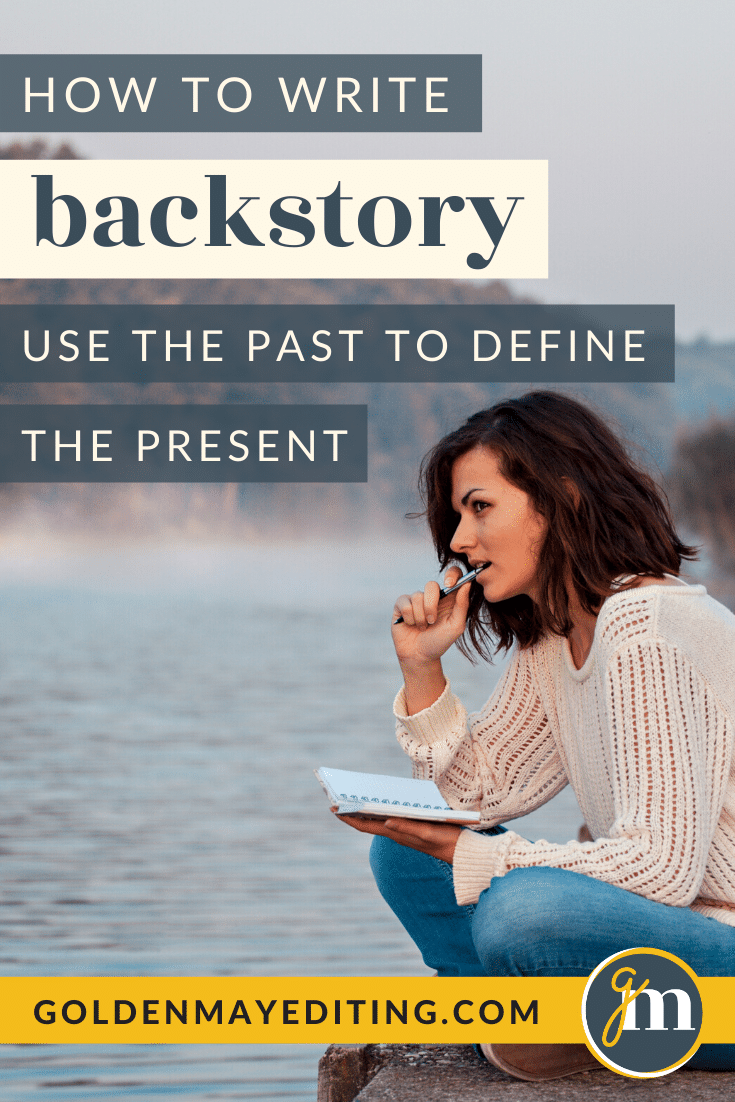This post/page contains affiliate links. We may receive a commission for purchases made through these links. Golden May will only ever recommend products or services that we fully stand behind! Thanks for your support.
As humans, we use our own past experiences to make sense of the present. Our past influences the choices that we make on a daily basis. The same is true of fictional characters. They should make sense of what’s happening in the present story through what’s happened to them in their past. Understanding your character’s backstory will allow your reader to empathize with why they act the way they do.
Backstory is how your characters understand the world around them.
Your character’s backstory is everything that’s happened to them before your story begins. It is the foundation for who your character is. Their past—what’s happened to them, and the choices they’ve made—shaped them into the person they are, determined their beliefs, their goals, and their fears.
In one of our favorite writing resources, Story Genius, Lisa Cron explains how backstory should be used. She says, “[backstory] gives us insight into how [the character] sees the world, what he values, and most important, why. And in doing so, it also gives us several salient details about his past, without once stopping the story”(emphasis added).
As a writer, backstory is one of the most powerful tools you have. Backstory can, however, be very tricky to implement—and when done wrong can lead to info dumps with little to no purpose that bore, distract, or disengage readers.
When developing a character’s backstory, you don’t need to know everything about them. To get to the heart of the character, you just need to know what events in their life influenced the development of their goals, fears, and beliefs. In this blog, we’ll dig into how to develop your character’s backstory and how to use it on the page in your scenes.
Developing your character’s backstory
Getting to know your character’s backstory doesn’t mean determining their relationship with their Great Aunt Sue, what their favorite breakfast was as a kid, or who bullied them in school—not unless these details are critical to the specific story you’re telling.
While exploring your character’s backstory, you should focus on the events and choices in their past that led to the development of the flaw that they’ll overcome in their character arc.
Character arcs illustrate how and why a person changes. The character opens the book with a misbelief, flawed worldview, or lie that’s getting in the way of their goals—what we call their Internal Obstacle. Through the story’s journey, if it’s a positive arc, they’ll overcome or unlearn this Internal Obstacle, and in doing so, change for the better.
Your character’s Internal Obstacle, however, doesn’t form on page one of your story. Once you know what Internal Obstacle you want your character to dismantle in your story, you need to determine where it came from. Who taught it to them? What experiences reinforced it? What choices have they made because of it? How has it shaped their life?
To establish your character’s backstory, we recommend the following steps:
- Determine your character’s Internal Obstacle. What misbelief, flawed worldview, or lie is keeping them from achieving their goals?
- Pick 3-4 moments in your character’s past when their Internal Obstacle developed. When was their flawed belief first seeded? When and how did it grow over time? How has it influenced their choices, and therefore the shape of their life?
- Draft those scenes! The best way to get to know your character is to sink into their skin by writing these critical moments in their past out on the page.
How to use backstory on the page
Backstory is how writers let readers in on who a character is when the story starts. When using backstory on the page in your actual draft, it’s essential to reveal it to the reader in the right way. Your character’s history, and how it impacts their thought processes, has to be woven into the present scene on the page.
When backstory is used effectively, readers not only learn about the character and who they are, but also how they understand (or misunderstand) what’s happening to them in the moment.
DO:
-
Have your character use their past to understand their present. The consequences of past choices your character made (or saw others make) will inevitably impact the choices and assumptions they make in the present.
-
Use backstory as a way to help the reader understand what your character wants, why, and what they think is in their way.
-
Weave backstory into your character’s thoughts, dialogue, and observations as they’re analyzing and making meaning of what’s happening to and around them.
-
Make sure backstory details are always revealed when they’re relevant to the character’s story present.
DON’T:
-
Don’t use backstory upfront to “fill readers in on what they need to know” before the story started.
-
Avoid dumping random facts or history about your character because it seems interesting or cool.
-
Never stop the story itself in order to inform readers of something important.
-
Don’t let backstory that’s irrelevant to the immediate scene present confuse the story’s flow.
Example! Backstory in Action
Let’s take a look at an example of backstory from Chapter 6 in A Court of Thorns and Roses by Sarah J. Maas. Feyre, the main character, murdered a Fae while hunting for food for her starving family. Another Fae comes after her and demands she come with him back to Prythian (the land of Faeries) as punishment or he will kill her and her family. This excerpt is from Feyre’s first night at the Fae’s estate.
“She returned with trousers and a tunic that fit me well, both of them rich with color. A bit fancy, but I didn’t complain when I donned the white shirt, nor when I buttoned the dark blue tunic and ran my hands over the scratchy, golden thread embroidered on the lapels. It had to cost a fortune in itself–and it tugged at that useless part of my mind that admired lovely and strange and colorful things.
I was too young to remember much before my father’s downfall. He’d tolerated me enough to allow me to loiter about his offices, and sometimes even explained various goods and their world, the details of which I’d long forgotten. My time in his offices–full of the scents of exotic spices and the music of foreign tongues–made up the majority of my few happy memories. I didn’t need to know the worth of everything in this room to understand that the emerald curtains alone–silk, with gold velvet–could have fed us for a lifetime.
A chill scuttled down my spine. It had been days since I’d left. The venison would be running low already.”
Feyre remembers these memories of her childhood as she puts on the rich and lavish clothes given to her by her Fae captors, a sharp contrast to her old ragged clothes. As she processes her captivity and surroundings, we’re given a snapshot into her past that helps us understand a few things about her: she’s far from her comfort zone in this extravagance, she ties wealth together with love, and she feels deeply responsible for her family’s survival. Through this scene-present backstory, we learn more about what Feyre values, what her goals and fears are, and how she sees her current world.
Backstory Checklist
We put together a helpful list to check yourself against as you write. Use this to make sure your backstory is effective and not info dumping!
-
Does the backstory illuminate your characters’ thoughts or decision-making in the story present? (Is their thought process on the page?)
-
Is it clear that the character’s backstory is the foundation for their goals and fears?
-
Does the backstory focus on telling the reader facts (info dump), or does it serve as a snapshot into the character’s head to frame their present?
-
Does your use of backstory muddy the timeline of the present, or is the story present still clear?








Leave A Comment